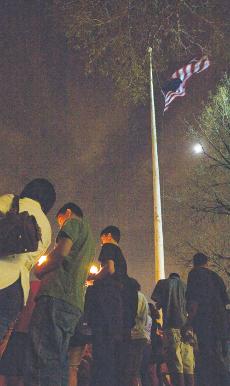Sunni and Shia

Abdu Wahab, a recent UMB graduate.
February 26, 2007
Former US ambassador Peter Galbraith reported in his 2006 book, The End of Iraq: How American Incompetence Created A War Without End, that our president and current commander-in-chief of the War in Iraq had been largely unaware, even within months of the beginning of that war, to the difference between the two major religious sects that exist within the country that the US would shortly be invading.
In a meeting held with several Iraqi-Americans to discuss the post-Saddam outcome of the war, Galbraith claimed that Bush had little real knowledge of a religious diversity existing within Iraq. When explained of the different Sunni and Shia sects of the Islamic religion that live in the country, a bewildered Bush allegedly responded, “I thought the Iraqis were Muslims!”
But is this so important? Such a fundamental lack of cultural awareness need not necessarily stand in the way of military strategy, some may say. Mere semantics, others could argue-in a time of war, all enemies look the same.
But a little more than three-and-a-half years since the invasion of Iraq, several things have become increasingly and indispensably clear. Hindsight is 20/20 and the US could have, and should have, known more about the cultural dynamic that they were about to get involved with. In a conflict of regional strife and sectarian violence, it is imperative that we possess an intimate understanding of both the cultural and religious nature of the country so that we don’t simply make divisions deeper.
“A good doctor first diagnoses the problem, and then treats its,” explains Abdu Wahab, a recent graduate from UMass Boston who recently lectured on Sunni-Shia differences in a talk sponsored by The Social Action Group. By way of analogy, Wahab is alluding to the fact that the US will continue to be incapable of addressing the problems that currently exist in Iraq, unless we acknowledge the complexities of its Sunni and Shia populations.
Wahab is in a position to speak authoritatively on the importance of this cross-cultural understanding, being an Iraqi citizen himself. He came to this country more than two years ago to study American Literature on a Fulbright Scholarship so he could attend graduate school at UMass Boston. His flight back home to the Kurdistan region of northern Iraq left about a week ago, but before leaving, Wahab was able to speak with the Mass Media for a critical look at US-Iraqi relations.
“The US was so eager to announce ‘Mission Accomplished,’ more than really accomplishing that mission,” Wahab said when explaining the lack of foresight that this administration had in dealing with Iraqi culture.
Success has proven itself to be more difficult than originally conceived and so this is why it is critical, if somewhat belated, that the US strives to understand the nature of the conflict that Iraqi citizens, and the American Troops stationed over there, are in today. To do this, Wahab explained, we must understand who these people are, how they are different, how they are the same, and if they share the same vision for Iraq that the US does.
Many Americans assume that the current sectarian struggle is merely religiously incompatibility. “This is one misunderstanding of the issue,” Wahab said. “It started politically. It’s a political division and has been political all the way.”
He explains that the separation of these two denominations occurred around 14 centuries ago, shortly after the death of Muhammad, Islam’s founding prophet. Without an established rule for succession of the religious leader known as the caliph, an Arabic word meaning “successor,” it would be only several generations before a disagreement emerged over the proper line of this succession. Sunnis followed a line of elected succession stemming from the first four caliphs, while Shi’ites maintain that the caliph must be of the blood descendants of Muhammad alone, a tradition which stems from Muhammad’s son-in-law, Ali.
But Wahab’s emphasis on the Sunni-Shia split being a struggle for power as articulated through religion, is one that is not wholly foreign to the West. Religious differences have long been the cosmetic consequence of political and economic divisions.
“To have the support of the people, you need to give them something that’s related in one way or another to them. And what’s more related to people then religion? And that’s why they give it this spiritual difference and spiritual identity,” Wahab explained. As such, the current struggle in today’s Iraq is not wholly different. “To boost this division, to boost the political idea, you give some spiritual division to it. The bottom line is that every conflict between Sunni and Shia is political.”
But as is the nature of politics, political events have also served to unify Sunni and Shia Muslims. In the 1920s, the British colonial rule in Iraq only benefited from emphasizing the country’s religious division. However, it was only after Sunni and Shia were able to unite against the British that Iraqis of any denomination were able to win their independence.
“The Sunni and Shia fought together under the same name, Iraqi people, against the British rule in the 20s. And they had a different revolution against the Iraqi monarchy backed by the British in the 50s,” Wahab said. “When the Iraq-Iran war happened, and of course the West and United States supported Saddam Hussein in that war,” that unity began to first show signs of splintering. “When you are fighting against a country that are Shia [Iran], the Shia itself becomes something.”
The US today, much like the British had done before, would use this sectarian divide in order to support a Shi’ite resistance to Saddam’s secular, yet predominantly Sunni, government. Though pitting Shia against Sunni succeeded in achieving “de-Baathification,” the removal and effective banning of all former party members, and successfully led to the toppling of Saddam’s government, it was also a strategic miscalculation to assume this would then foster an environment for a new democratic state.
Unlike the Sunnis who see the caliph as a religious leader only, the Shi’ites view this role of the caliph as both a spiritual and political leader. This positions the Shia as being not particularly well-suited candidates for a democratic state as we understand it. “For Shi’ites, the leader of the Muslims should be the most religious; someone that’s divine from the family of the prophet,” said Wahab.
But speaking from first-hand experience, Wahab stressed that Sunni and Shia differences were not irremediable as many in the West may be lead to believe, but instead are largely a result of the social destruction resulting from the US invasion. In fact, there are a lot of examples in current-day Iraq that point to the hope that the Iraqi people, both Sunni and Shia, will be able to overcome their differences and restore peace to the conflict-torn country. Sunni and Shia lived together before the US invasion, and many still do. However, these are not the voices of peace that are picked up by the international public.
“Friendship doesn’t speak as loud as hatred,” Wahab said. He remains optimistic that real change is possible in his country. But it will not be a singular effort or one that can be forced upon unwilling participants. It will take shared effort of understanding and cooperation on the part of both the US and Iraqi citizens to address and resolves the problems that exist in the region.
“It’s not only the international community’s or the United States’ fault,” said Wahab. “Iraqis also have a lot of fault. But if there are honest people involved in the matter and can diagnose the problem, they can try to negotiate and give people some of their rights. The rest will be solved through conversation and communication.”





























































